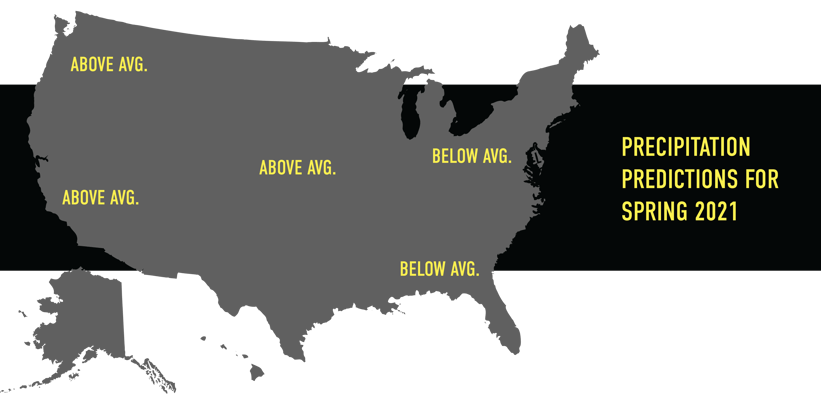In 2020, approximately 78 people perished in tornadoes across the United States. That was up from 41 deaths in 2019 and the most since 2011. The damage from tornadoes, flooding and other severe weather accounted for $2.4 billion in insured damages that year.
Because of their size and scope, commercial facilities can even be at greater risk. Severe weather can not only translate into facility damage but loss of inventory, equipment, jobs and income. The good news is there are steps you can take to better prepare your facility for the Spring severe weather season.
Here we will take a closer look at the severe weather outlook across the country for Spring of 2021, statistics regarding commercial property damage due to flooding, power outages and tornadoes and how you can be better prepared.
2021 Spring Weather Outlook

The National Weather Service (NWS) not only provides short-term forecasts throughout the United States but long-term and seasonal forecasts as well. Here is what they are predicting for the Spring (March, April, May) of 2021 broken down into five general regions.
Northeast
The National Weather Service predicts most of the Northeast United States including New England to be at or below normal when it comes to precipitation through the Spring. These mainly drier conditions will be accompanied by temperatures that will trend higher than average.
Southeast
The three-month outlook for March through May in the Southeast predicts temperatures to be warmer to much warmer than normal. These warmer temperatures will be accompanied by below average precipitation with the exception of Florida, where slightly higher than average precipitation is expected. It is important for people in the Southeast to note that May is the beginning of Hurricane season. Those in the Southeast should be aware of the increase in tornado possibilities during spring storms.
Midwest
The Midwest can expect more than average rain throughout the Spring this year according to the NWS. The chances for heavier than normal precipitation is predicted in particular for Ohio, Michigan, Indiana and Illinois. Temperatures throughout this region are expected to be higher than average.
Northwest
Temperatures in the extreme Northwest are expected to be colder than normal, with closer to average temps expected to the south. The extreme Northwest is also expected to be a bit wetter than normal, with closer to average rainfall to the south.
Southwest
Those in the South and Southwest can expect higher than normal temperatures and rainfall in the 90 days from March through May. Some of these temperatures and rainfall could be much higher, especially in the extreme south and west.
Preparing for Severe Spring Weather
The best defense against severe spring weather is a good offense. Knowing what’s coming your way is half the battle in preparedness. The other half is taking appropriate precautions. Implement these tips to prepare for common spring severe weather occurrences.
Preparing for tornadoes is important because, unlike hurricanes, they tend to come on unexpectedly, giving you little time to batten the hatches.
- Check your business insurance policy around tornado damage and update as needed.
- Always limit unsecured objects outdoors and make sure things like tall signage can withstand high winds.
- Keep your roof maintained and regularly inspected.
- Cut down any dead trees near buildings on property.
- Create an emergency kit and make sure staff knows where to find it. Include things like water, extra food, blankets and a radio for monitoring storm conditions.
- Practice tornado drills with staff regularly so they know where to go and what to do in the event of a tornado.
If your business is located in a space where you’re sure flooding will never happen, think again! Flooding isn’t just for businesses on the coastline or near lakes and rivers. Flooding can occur anywhere in the U.S., usually caused by flash floods during rainstorms, snow melt, mudslides, hurricane storm surges and more.
Though you may receive a flood warning or flood watch notification, there are many possible instances where they can occur suddenly. Here’s how to prepare your business for a flood.
- Make sure your business has updated food insurance.
- Understand the difference between flood warnings and flood watches.
- Keep an extra copy of all important documentation in a safe, waterproof place at all times.
- Become familiar with the mechanisms to shut off gas, water and electricity in your facility.
- Install check valves in sewer pipes.
- Keep an emergency kit on hand with a weather radio and battery backup. Keep in mind, your flood emergency kit and tornado emergency kit can be the same kit!
How SRM Can Help Your Business Before, During and After Severe Weather
Being prepared for severe spring weather can minimize downtime and losses for your commercial enterprise. It can help you keep valuable employees by getting them back to work sooner, and limit service interruptions to customers. That’s part of the mission at ServiceMaster DSI.
The innovative SMDSI Pre-Disaster Program is unlike any other in the industry. We partner with our clients before, during and following events to minimize risks, limit claims and reduce business interruption. SMDSI has revolutionized how commercial properties should look at their disaster restoration partner.
ServiceMaster DSI has responded to every major disaster in the United States in the past 20 years. Secure our assistance and expertise before, during and after any severe weather damage with the help of SRM. Sign-up for ServiceMaster DSI’s Pre-Disaster Program today.

